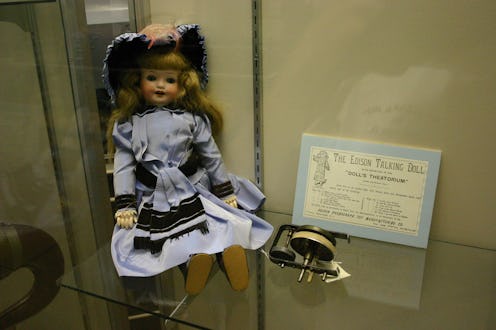
Just in case you needed some nightmare fuel for tonight, here's a wacky little tidbit for you: Thomas Edison's talking dolls' voices have been restored, and they're creepy AF. I'm not kidding. They are terrifying. I mean, I realize they weren't meant to be terrifying back when they were shiny and new — but it's amazing what a century or so will do to an ancient sound recording of a freaky little nursery rhyme, isn't it?
You probably already know that Edison invented the phonograph in 1877, a device that worked by recording sound on wax or metal cylinders which it could then play back. But what you may not have known is that, following this innovation, Edison also came up with a way to turn it into a toy: A doll that spoke to its owners.
Edison wasn't the only person to conceive of a talking doll; according to the Thomas Edison National Historical Park's website, the first patent ever filed for such a toy went on the record in France circa 1823 or 1824 (the inventor's name was Johann Nepomuk Maelzel, and his patent was for a “talking doll, which pronounces the two words papa and maman”). I gave Google Patents a search to see if I could find when the first patent for a talking doll was filed in the U.S.; I came up with a listing submitted by one William A. Harwood, from Brooklyn, in 1877, but it's possible that there are older ones I failed to find (I tried searching for “talking doll,” “crying doll,” and “speaking doll,” for reference).
Just for the record, that right there is the freakiest doll GIF I've ever found.
Anyhoo, Edison's invention did something most of the other talking dolls on the market didn't do at the time: It was capable of saying more than one word at a time. This had to do with the technology available at the time, which was, to say the least, rudimentary (writes the Thomas Edison National Park website, “In fact, it was the only regularly manufactured product based on an older species of 'talking machine' which relied on imitating the mechanical working of the human speech organs by means of reeds, bellows, and the like”). The Edison dolls actually came equipped with tiny little phonographs inside them which played nursery rhymes from the same sorts of wax and metal cylinders the full-sized phonographs used.
Edison's Phonograph Doll, as he called them, hit the market in 1890 — but alas, they were abysmal failures. Production on them ceased just a month after their launch, and they joined so many other failed inventions on the scrap heap of history. Of course, this same scarcity later led to them being a much sought-after and valuable collector item; only a few remain in the world, and the one that the National Parks managed to get their hands on came with a metal cylinder so bent out of shape it was virtually impossible to play.
Technology, however, is a wonderful thing: A new audio reclamation system called IRENE-3D has been used to reconstruct the cylinders, which has enabled the restoration of the doll's original sound recording. According to CNET, IRENE-3D works by using a “three-dimensional optical scanning system that creates a digital model of the surface of a phonograph…. These models are then analyzed to digitally reproduce the audio recorded on the phonograph, converting it into a WAV file.” So far, they've been able to restore and/or digitize eight recordings, three of which are examples of “Twinkle Twinkle Little Star.” You can listen to them online… but to be honest, I'm not totally sure you'll want to.
If you're familiar with a particular subset of topics I ocasionally write about, both here on Bustle and elsewhere, you'll know that I have a pretty high threshold for creepy stuff. But these recordings? I only lasted through a couple of seconds before I had to turn them off. I am not at all ashamed of this fact, either, because they're so effing freaking. Seriously, you guys. I wasn't joking when I said they were nightmare fuel.
Don't believe me? Here, have a listen — and make sure you put your headphones in and turn up the volume before you hit “play”:
KILL IT. KILL IT WITH FIRE.
Actually, no, don't do that — it's a historical relic, so we should probably do our best to take care of it. But does anyone else think any doll that makes those kinds of sounds should be kept under glass like Annabelle? I mean… yikes. Just yikes.
Head on over to the National Parks' website to listen to the other seven recordings from Edison's Phonograph Dolls. You weren't planning on sleeping tonight anyway, right?
Images: Genista/Flickr; Giphy (2)